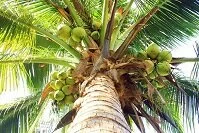Although cyclones are well known throughout the Pacific, Kiribati falls out of the cyclone zone. Despite this, heavy storms and cyclones can still hit the islands any time of year, but are most common from November to May.
Wildlife

Coconut tree
The number of native plants and animals in Kiribati are very limited since the country is an island nation. Despite its many islands and great length, Kiribati's native land animal life is almost non-existent and the plant life is nearly as absent. The migrating birds and sea life had the most significant presence in creating today's plant and animal life. Much of what is found on the islands today was introduced in pre-historic times by the migrating people, birds, winds, and ocean currents.
As an island nation that rose from the sea floor there were no native mammals in Kiribati, although a few bat species arrived thousands of years ago. Some species of rats also made their way to the islands hundreds, if not thousands of years ago. Other than this, no land mammals existed in Kiribati until the arrival of the earliest people, who brought with them dogs and pigs.
The seas are also home to mammals including dolphins and whales who call the surrounding waters home. These waters are also filled with thousands of fish, shellfish, and other forms of sea life. This sea life includes surgeonfish, clownfish, sailfish, puffer fish, butterfly fish, grouper, barracuda, tuna, snapper, bonefish, mackerel, marlin, mahi-mahi, shrimp, krill, crab, seahorses, manta rays, sharks, jellyfish, starfish, sea urchins, and coral among many others.
The water and the land have attracted more than just fish; they have also attracted numerous birds, including many that feed off the animals in the sea. The bird life in Kiribati includes frigatebirds, doves, parrots, ducks, heron, terns, warblers, pigeons, and cuckoos among others.

Sugarcane
Like the mammalian life, the reptilian and amphibious life is fairly limited. The most common of these animals are those adapted to the water and swimming as sea turtles can be found in the nearby waters. Land species have again made their way to the islands in numerous methods and today lizards, snakes, and geckos are among the most common of these animals.
The insect and other small animal life is fairly diverse as many insects can fly or float and have made their way to Kiribati. These animals include butterflies, moths, beetles, bees, ants, flies, snails, spiders, and mosquitos among others.
The plant life, like the animal life, is limited due to geography and climate. The winds and water currents have taken seeds to the islands and in other cases birds have transported seeds to the islands. Because of this, many of the more commonly known plants on the islands today are not actually native to Kiribati, but rather arrived from distant islands like New Guinea and those further west. These plants, or their seeds, arrived with animals, people, winds, and ocean currents from island to island until they reached Kiribati. Plants from these islands, that now thrive in the country, include coconuts, taro, breadfruit, bananas, yams, arrowroot, lemons, and sugarcane among others.
There is also a presence of other trees and plants, including orchids, hibiscus, eucalyptus, frangipani, pawpaw, ferns, mosses, mangrove trees, and pandanus trees.